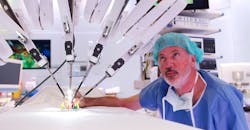It seems like only the manufacturing sector has been using industrial robots—mostly in in production and packing lines—since the 1960s. However, as technology advanced in the last decade, robots have begun to break out of their industrial cages and find employment in an array of other applications.
The Financial Times, for example, reported that the robot market is set to be worth $135 billion by the end of this year 2019. It cited two key indicators predicting the boom we’re seeing. The first was a tripling in the number of robot technology patents filed globally over the last 10 years. Second, venture capital investments in robotics more than doubled in 2015, climbing to $587 million.
All these patents and investments are now bearing fruit. Robots are ready to roll from testing labs and assembly lines to arrive in sectors not traditionally accustomed to robotics or automation, such as healthcare and energy generation. While this creates exciting new opportunity for these industries, it also puts pressure on suppliers to provide specialist components required for robots to be deployed in these industries:
Marine. Robots for underwater inspection and construction are proving invaluable for developing and maintaining hydropower sites, vital sources of renewable energy. These robots work in areas considered too dangerous for human divers.
Value Market Research predicted the unmanned underwater vehicles (UUV) market would grow from $3.2 billion in 2017 to $6.2 billion to $8.2 billion by 2022 at a compound annual growth rate of 14.1%.
This creates a need for components that perform underwater without losing the precision associated with robots. Bearings for such applications must withstand strong currents and tides, and as such probably need to be made of ceramics or marine-grade 316 stainless steel.
Medical. The medical robots and computer-assisted surgery field will grow from $4 billion in 2016 to $6.8 billion by 2021, at a compound annual growth rate of 11.3%, according to BCC Research. The need for better patient recovery rates, more advanced surgeries, and shorter waiting times are creating a need for more advanced surgery methods and robots are being called on to help.
Again, special applications mean special robot components, especially in a field as regulated as the medical sector. Some medical devices must perform in clean environments without the lubricant outgassing to contaminate the area. Precision stainless steel bearings with cleanroom lubricants are vital to keep these medical machines efficient and safe.
Collaborative. The arrival of collaborative robots is changing how factories use robots. Collaborative robots represent a safer, more human-friendly way to put robots onto production lines and can work directly beside human workers.
To maintain safety, these robots rely on sensors to respond to their human colleagues, stopping if they are on a collision course. To ensure they stop or move as needed for their entire lifespan, components need to be extremely precise and hardwearing. Space is also limited, as collaborative robots are often smaller than traditional industrial robots, so miniature parts such as thin-type precision bearings are in great demand.
Sourcing special components has always been a challenge. However, until recently, the use of robots in hospital surgeries or underwater was rare, so catering to niche requirements hasn’t been too much of a problem for suppliers. With the niche becoming normal, specialized components are in demand, which is creating a shortage of some essential industrial parts.
This is something we have experienced firsthand at our bearing company. In fact, we have had to invest to sidestep the shortage. Adjusting the warehouse and changing our methods of stockholding helps us ensure customers from the medical equipment, marine, and manufacturing markets are not left without the bearings they require.
If suppliers don’t prepare to improve stocks of precision and niche products, it could slow the spread of robots.
Chris Johnson is managing director of SMB Bearings. If you have questions about bearings or robots, call 01993-842-555 or visit www.smbbearings.com.

